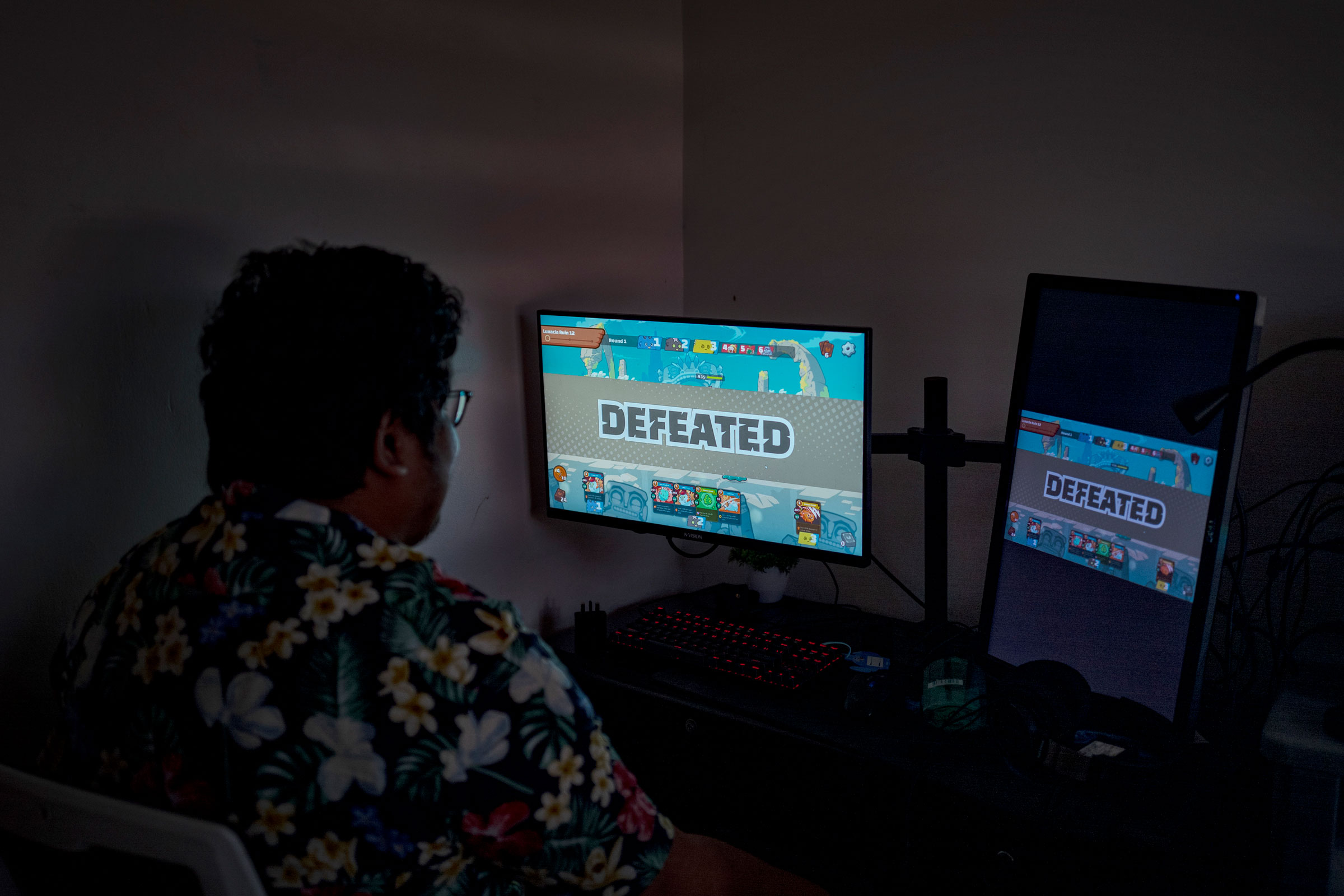Samerson Orias was working as a line cook last year in the rural Philippines when his friend told him he could make way more money playing a new video game.
Orias was earning about 4,000 pesos a month (about $80, a little less than half the national minimum wage) making takoyaki—Japanese octopus balls. His friend told him he and others were pocketing up to $600 a month playing Axie Infinity, a game fueled by cryptocurrency and NFTs.
Orias, now 26, desperately needed an escape hatch from his financial woes: his mother had had a stroke and required medication, and electricity and grocery bills were stacking up. So he plunged into Axie, doing battle with cartoon monsters for hours deep into the night. He soon began earning cryptocurrency, which he converted into pesos, allowing him to take better care of his mother and his home. At the same time, thousands of young people in the Philippines were jumping headlong into the game. For a brief moment at the peak of crypto’s astonishing 2021 boom, these young Filipino players were fulfilling a longtime dream of crypto’s most ardent evangelists: that “play-to-earn” blockchain games like Axie could lead the way to a more equitable, opportunity-rich global economy.


Fourteen months later, most Filipino players, including Orias, have exited the game nursing anger and anxiety—and, in some cases, thousands of dollars down. Orias grew to hate playing the game. It was boring and stressful, he says, a common refrain among the dozen players TIME interviewed for this story. “I felt fatigued all the time. I became more aggressive in every aspect of my life,” he says.
The story of Orias and Axie Infinity serves as a cautionary tale for crypto and its bombastic rhetoric about changing the world. Many crypto thought leaders, when rebutting criticism about the unsavory aspects of the space, point to its impact in developing countries. But Orias and others say that Axie Infinity reinforced predatory systems and gave them false hope. Innovative metaverse ideas like Axie Infinity offer immense promise—but also tangible peril for those who feel they have no other option but to take the plunge into the digital unknown.
The Play-to-Earn Dream
At first blush, Axie Infinity looks a lot like Pokémon. To enter the game, players buy three cutesy cartoon monsters called Axies, each of which has its strengths and weaknesses. They then battle other Axies, which makes them more powerful. Along the way, players earn in-game currency called Smooth Love Potion (SLP), which can be exchanged for other cryptocurrencies. You can also sell your Axie or breed new, more valuable monsters. Each Axie monster is an NFT: a unique non-fungible token whose ownership is recorded on the blockchain, a secure ledger of transactions. This technology has been touted by many as a potential backbone of metaverse development.
Axie Infinity was created by a Vietnam-based startup called Sky Mavis Inc. as part of the rising play-to-earn gamer movement. For other popular games like League of Legends and Fortnite, it’s common for elite players to make a living through sponsorships and revenue from streaming their games to online viewers. With Axie Infinity, the earning potential is baked right into the game play itself. “We believe in a world future where work and play become one,” the game’s website stated last year.
Sky Mavis takes a cut of in-game transactions and sits on a large stash of tokens. By last October, the company had raised more than $150 million from investors including the venture-capital firm Andreessen Horowitz.
The game initially made a huge impact in the Philippines. At one point, players there made up 40% of the game’s user base. Roughly a quarter of the Southeast Asian nation of 110 million people lives below the poverty line, and its economy is heavily dependent on some 2.2 million migrant workers who send money back home. But as the pandemic shut borders across the globe and slashed jobs, many of these workers were sent home. As prolonged COVID-19 lockdowns crippled the local economy, many resorted to multiple money-making schemes to make ends meet.
Owen Convocar, a Rizal-based gamer, heard murmurs about Axie’s earning potential for months in early 2020 before he decided to enter the game as a scholar. In 15 days, he earned $487. He soon invested $1,200 to buy his own Axie monsters, splitting the total cost 60/40 with his mom.
The early pandemic-era victories of players like Convocar brought global news coverage and hundreds of thousands of new players into the game. But as the game’s popularity increased, observers pointed out that its economic structure was unsustainable: the value of SLP necessitated new players continually buying in, much like a Ponzi scheme. Sky Mavis’ team even acknowledged in its white paper that the game was “dependent on new entrants.”
“Focusing on growing a network through early incentives does not make a Ponzi scheme,” a representative for Sky Mavis wrote in an email to TIME. “Axie Infinity’s main purpose is to provide entertainment.”
As the price of SLP continued to shoot up last summer, many aspiring players found themselves unable to afford the cost of purchasing their starter monsters. So an employment scheme emerged in which wealthier investors, known as “managers,” would buy Axie monsters and then lend them out to “scholars,” who would handle the grunt work of leveling up. The owners of the monsters would then pocket anywhere from 30% to 50% of the scholars’ profits, according to players interviewed by TIME. The system was unregulated, with Axie owners forging the terms of the contracts, which they portrayed as a way to spread the wealth. Orias hoped to be one of the system’s beneficiaries last May, when he signed up with a manager based in Australia. The manager required him to earn a minimum of 120 SLPs a day—which would take five to six hours of game play—and would pocket half of Orias’ earnings.

So Orias developed a daily routine in which he cooked takoyaki from 3 p.m. until midnight, came home, and played Axie through the wee hours of the morning. His play earned him badly needed cash: about $29 a week, after giving the same amount to his manager. But his relentless schedule, and the game’s randomness, exhausted and frustrated him. “At first I was happy. But after some time, I noticed I was slowly getting weaker. There was sleeplessness and the stress of the game,” he says.
And in August, Orias would come back to the game each week to find the real-world value of in-game currency was falling. As more players entered the game and generated more and more SLP tokens, each token’s value decreased. By November, the research firm Naavik reported that average earnings for Axie scholars had dropped below the Philippines’ minimum wage.
By spring 2022, the bottom had fallen out of the crypto market, making playing the game nearly worthless. While Axie Infinity boasted over 2.7 million daily active users last November, only 760,000 are still active, according to one tracker. The value of SLP peaked at $0.34 last July; it’s currently worth less than half a penny.
And as Sky Mavis tried to tinker with its game design to make it viable again, a much bigger disaster hit. In March, a hacker targeted the “bridge” upon which money was transferred between Sky Mavis’ blockchain Ronin and the much larger cryptocurrency Ethereum. (Bridges between chains are one of the least secure parts of blockchain ecosystems.) More than $600 million was quickly drained from the network, with two-thirds of that belonging to users themselves. While Sky Mavis returned all funds, the hack demoralized the game’s user base.
At the moment, Sky Mavis is making a hard pivot, de-emphasizing Axie’s “play-to-earn” nature and introducing a new version, Axie Infinity: Origin, that doesn’t involve crypto at all. They hope players will stick around for the game play itself, and to make money through in-game experiences and purchases.
Meanwhile, vast amounts of money are still being pumped into the blockchain gaming industry. In April, the gaming organization Ready Player DAO received a $150 million valuation in a new $10.2 million funding round. But Ethan McMahon, an economist at the research firm Chainalysis, says Axie’s failures portend badly for crypto’s once rosy play-to-earn future. “Maybe a select group of the best players will actually be able to earn from games. But any given person’s starting motivation to play will not just be for profit,” he says.
And Filipino scholars, who were told that blockchain games would bring radical economic change, are walking away confused and jaded. Several scholars TIME talked to said they owe hundreds or even thousands of dollars to friends or family who helped them pay the initial investment, only for their monsters to become worthless. Convocar’s Axie account was hacked in March, and recouping his losses set him back some $190. “I took good care of my Axies, and my account became invalid,” he tells TIME. He soon quit.

Orias drifted away from the game toward the end of last summer, after his mother died of a heart attack. Her funeral wiped out his savings, including the $200 he had saved up playing Axie. “I felt regret that I wasn’t able to provide for my mom,” he says.
Now he’s back in the takoyaki stand, and hopes to save up for a food stand of his own. “For those having a hard time, for those pushed to their wit’s end,” he says of Axie, “stop playing.”
—With reporting by Julia Zorthian
More Must-Reads from TIME
- Inside Elon Musk’s War on Washington
- Meet the 2025 Women of the Year
- The Harsh Truth About Disability Inclusion
- Why Do More Young Adults Have Cancer?
- Colman Domingo Leads With Radical Love
- How to Get Better at Doing Things Alone
- Cecily Strong on Goober the Clown
- Column: The Rise of America’s Broligarchy
Contact us at letters@time.com